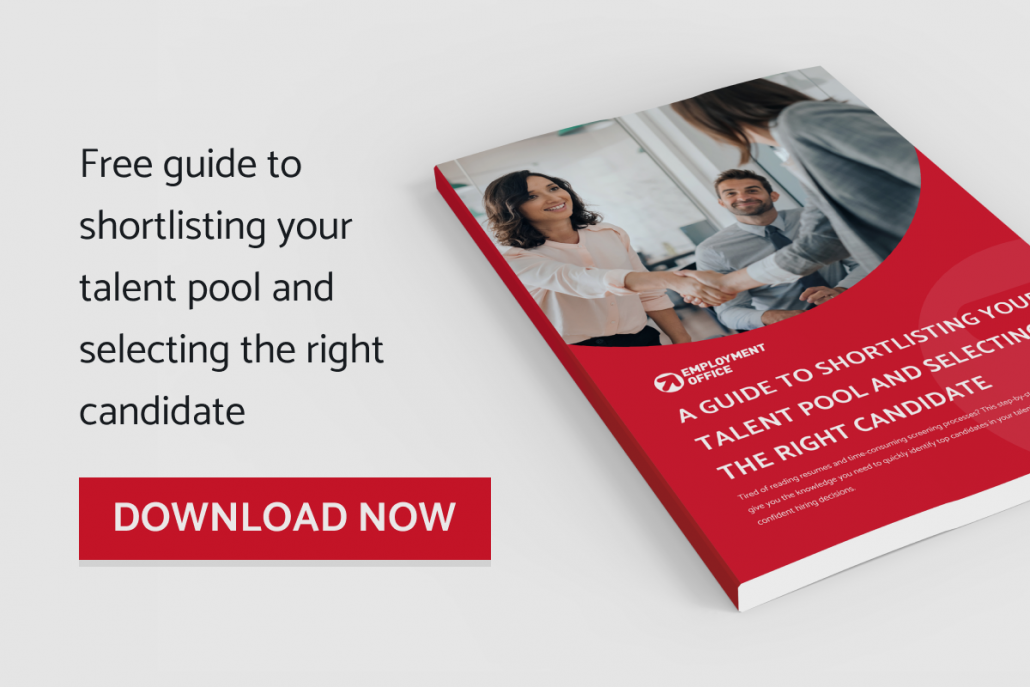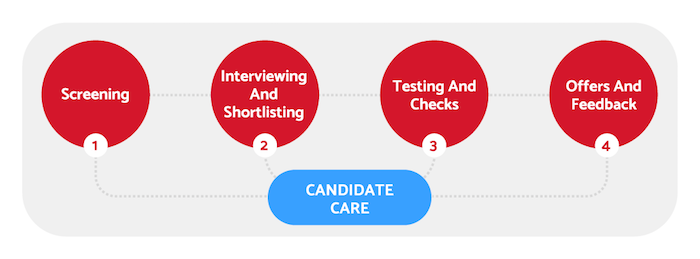Due to the high number of people entering the job market, organisations are receiving more applications than they can handle and are having a hard time filtering, selecting and interviewing the best candidates.
This step-by-step guide (containing digital solutions for social distancing regulations) will give you the knowledge you need for identifying top candidates in your talent pool and selecting the right candidate. Make confident hiring decisions and facilitate excellent candidate care (something candidates are relying on from employers during this time).
If you’re facing this challenge, we want to ensure you don’t miss out on the best talent. There’s more to selecting the right candidate for your role than screening resumes and conducting interviews. Your shortlisting and selection process should be multi-layered to gain deep insights about your candidates.
This guide will take you through the full spectrum of our best-practice process for shortlisting your candidates to ensure you select the right person for your vacancy. Our guide also includes our top candidate care tips, because now, more than ever, candidate care is critical to your brand perception.
Download your free copy of this guide
Each stage gives you great insights into candidates’ ability to perform in the job. The final stages, testing and checks, give you key information – but often, this is skipped by hiring managers! It’s important to work through these four stages to ensure you can make the most accurate hiring decision.
Let’s take a look at each of the four levels in turn.
1. Use efficient screening methods
Here’s how to speed up screening and ensure you’re making fast, accurate decisions.
Conduct a thorough job analysis
Accurately determine key selection criteria and competencies by conducting a thorough job analysis. This not only enables you to write effective recruitment advertisements, but conduct a better shortlisting process.
Include all relevant members of your team (i.e., future manager, HR team, recruiter) so every decision maker is on the same page about key selection criteria before you start screening candidates.
Refer to your position description and gain additional input from your team. Decide on “must-have” versus “nice-to-have” requirements, in relation to their experience, qualifications, and behavioural attributes. This will help you screen with more efficiency, give you greater clarity and a better chance of finding the right person for the role.
Tip 1
Knowing your key selection criteria will also help you determine the right interview questions to ask.
Tip 2
Did you know Employment Office offers Job Definition Surveys, helping you understand the ideal behavioural attributes for a person to perform well in a role?
Request information from applicants
Once you’ve conducted your job analysis, determined your key selection criteria (“must-have” and “nice-to-have”) and all your key stakeholders are on the same page, it’s time to determine the information you need to request from candidates.
Seek written communication in the form of resumes and screening questions.
(Depending on your brand, the tools you have in place and the preferences of your hiring team, video applications can be another interesting way to request information from candidates.)
Resumes – Look for relevant qualifications, education, training and experience which were outlined as critical (“must-haves”) in the job analysis.
Tip 3
In recent years, with the increase of online application systems, cover letters have arguably become less of a necessity. Candidates use stock-standard templates and they can be time-consuming for you to review. Not requesting a cover letter can speed up candidate application times, and therefore, reduce drop-off rates and increase the quantity of applications you receive.
There’s a solution! Use screening questions that target your key considerations, and use these in place of cover letters.
Video applications (optional) – Look for one or two key takeaways about candidates’ interest in the role, and what they think makes them suitable for the role.
Video applications are rising in popularity. Organisations typically request short videos (1-2minutes) from candidates asking them to share their interest in the role and what they think makes them a great fit.
Depending on your target talent demographic, it can be a great way to improve the candidate experience and increase engagement.
But note, be careful of bias.
Screening questions – Assess your candidates’ communication skills and how they compare to your key selection criteria.
If you’ve ever wanted a better solution to screening resumes, screening questions are your best bet. Opening and reading through resumes and cover letters can typically take up to five minutes per application. If you have 300 applications for a graduate role, that’s a huge time investment…25 hours to be exact!
Screening questions can help you dramatically cut down that initial time investment and help you identify your top people to progress with quicker.
If your company has a Candidate Management System for your recruitment, it’s likely that you’ll be able to ask application questions as part of the process. If you’re collecting resumes via email or through job boards such as Seek, there may not be the option to include those questions formally, however you certainly can ask as part of your advertisement for candidates to address your questions in a cover letter – thereby still giving you the information you need to make your assessment.
Compare apples with apples by asking standardised screening questions (assessing candidates across “like-for-like” questions). Ask questions relevant to the information you need to assess knowledge, skills, training, education and experience. Screening questions reveal a candidate’s motivation and level of interest in the position (i.e., someone who answers thoughtfully with examples and insights would appear more interested and motivated by the position than someone who answers briefly).
Design the questions around your key selection criteria and ask for examples. For example, screening questions for a supervisor position might include:
- “Detail your supervisory experience and describe your leadership style.”
- “Describe a time when you have been responsible for implementing a new policy or procedure.”
Tip 4
There’s no hard and fast rule about how many screening questions you should use. At Employment Office, we recommend 2-4 radio-button questions (e.g., “Do you have the right to live and work in Australia?”, Yes/No) and 4-6 long-form questions (e.g., “Describe your leadership style”) to target key information, without impacting application drop off rates.
You don’t want to deter candidates from applying by requiring too much time investment at the first step of the process, but you do want key information to help you screen quicker and more effectively. Just be mindful that the more hoops you ask a candidate to jump through the harder it is for them to apply. You want a good combination of qualitative and quantitative data.
Tip 5
Think of this first round of screening like a “first date”. You want to know enough about them to know if you would like to see them again, but not interrogate them for their life story before you’re sure you want a second date.
Assessing applications
After you’ve established your criteria and determine the communication you need from candidates to move forward, it’s time to start assessing applications. Depending on your role, brand and industry, you may receive a few (or a lot!) of applications. You may like to check in every day or second day to assess candidates and determine the effectiveness of your recruitment advertisement.
When assessing applications, keep your key selection criteria front of mind.
Tip 6
The right technology and screening tools, such as a Candidate Management System (CMS), can work wonders in reducing your screening time. A CMS allows you to set up automations to include/exclude applications based on set criteria. For example, you can automatically exclude candidates who don’t have the right to live and work in Australia.
Talk to Employment Office for recommendations about cost-effective screening tools, a CMS, or some extra support with shortlisting.
Tip 7
Facilitate great candidate care by issuing feedback at the 2-3 week mark to let candidates know you’re still assessing applications and that all candidates should expect to hear within a set timeframe.
Use consistent communication to invite top candidates to the next stage of your recruitment process: interviews.






